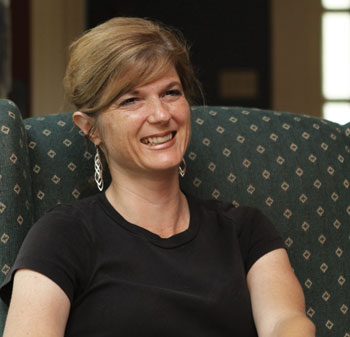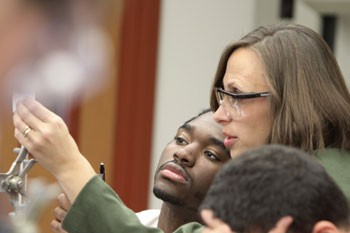To Live Humanely |
| Printer-friendly version | Email this article |
|
Collaboration Questions Genetics Testing in the Classroom Articles written by and describing a classroom collaboration between Pre-Health Advisor Jill Rogers and Haines Professor in Biochemistry Ann Taylor have been published in two academic journals and are a catalyst for discussion in the national Society of Genetic Counselors. “Teaching About Genetic Testing Issues in the Undergraduate Classroom: A Case Study” was published in the Journal of Genetic Counseling in June, and “The Ethical Implications of Genetic Testing in the Classroom” was published in Biochemistry and Molecular Biology Education in July. Both describe a class Taylor taught with input and assistance from Rogers. “My background is in clinical genetics and genetic counseling, and Ann is interested in innovative pedagogy and engaging students through real-life scenarios in the lab,” Rogers explains. “My professional community is very sensitive to the idea of doing any medical testing outside of a medical setting; we feel very strongly about informed consent. We want those we’re testing to thoroughly understand the implications of any test we’re doing.” Taylor had found several case studies in which students at other colleges had examined their own DNA for irregularities associated with an increased risk for developing disease, including cancer. “Ann and I got into a discussion about where the line might be between an interesting inquiry in the lab and a medical test, not to mention the fact that no ethical guidelines seemed to be in place for these situations. “We thought it would be interesting to allow students to learn and do some basic DNA manipulations in the lab using their own DNA so they could understand how that is done.” Then, at the point at which students were about to analyze a particular gene, Rogers intervened. “I came in and said, ‘Before we actually analyze the gene, let’s talk about what this means. Let’s talk about what sort of ethical obligations we need to fulfill before you get this information.’ “We discussed the core bioethics principles that genetic counselors talk about—informed consent, autonomy, and beneficence. We asked, ‘What if we found out from this analysis that you might be at increased risk for cancer or heart disease? How are you going to handle this information?’” The students concluded that the class did not meet the ethical standards necessary to do the testing. “But this is a worthwhile study even for people who aren’t scientists. We live in an age of direct-to-consumer testing, where you will soon be able to walk into a drug store and pick up a kit and test your saliva and find out, ‘Gee, I’m at increased risk for Alzheimer’s.’ We’re all going to have access to information that we may not be ready to have, and we may receive it when we don’t have the emotional support to handle it.” Rogers is presently on a task force of the Society of Genetic Counselors looking into the issues raised by this sort of classroom testing. “We’re still in the early stages of discussing this,” Rogers explains. “Our next step would be to develop ethical guidelines for teaching genetics in the classroom.”
Top Photo: Jill Rogers
|


 “So rather than doing the last step and analyzing the gene, they wrote papers about why they felt they shouldn’t. It was a great approach—it gave them the skills of doing the laboratory technique, sure, but these students are scientists, many are going on to medical school, and they’ll be in positions of ordering this testing or interpreting it. This was a great way to give them some initial exposure to the implications of this sort of information.
“So rather than doing the last step and analyzing the gene, they wrote papers about why they felt they shouldn’t. It was a great approach—it gave them the skills of doing the laboratory technique, sure, but these students are scientists, many are going on to medical school, and they’ll be in positions of ordering this testing or interpreting it. This was a great way to give them some initial exposure to the implications of this sort of information.